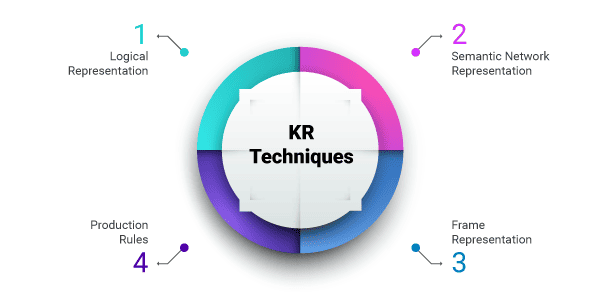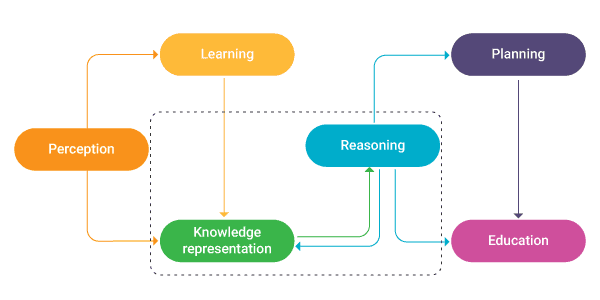What is Knowledge Representation?
There are two primary concepts in Knowledge Representation:
#1Knowledge
#2Representation
- Objects: All the information related to the objects present in our world. For example, buses need drivers, cars have wheels, guitars have strings, etc.
- Events: Numerous events that are taking place constantly in our world and the human perception of the events. For example, natural disasters, wars, achievements, etc.
- Performance: Deals with how humans react in various situations. Representing this knowledge is essential for the AI agent to understand the behavior side of knowledge.
- Facts: Knowledge based on the factual description of our world, such as the earth is not flat but also not an exact round.
- Meta Knowledge: Meta knowledge deals with the knowledge that we already know and allows AI to perceive the same.
- Knowledge Base: A knowledge base is a collection of information related to any discipline. For example, a knowledge base on road construction.
Want to bring AI into your business operations?
Different Types of Knowledge Represented in AI
Declarative Knowledge
Refers to the facts, objects, and concepts that allow us to describe the world around us. It shares the description of something expressed in declarative sentences which is simpler than procedural language.
Structural Knowledge
Constitutes the problem-solving knowledge that describes the relationship between various concepts or objects and their descriptions.
Procedural Knowledge
Also known as imperative knowledge, procedural knowledge is used to complete any task with specific rules, strategies, processes, or agendas. It’s the type of knowledge which is responsible for knowing how to do a particular task and hence relies on the task we are trying to finish.
Meta Knowledge
As mentioned above, meta knowledge refers to predefined knowledge about things that we are already aware of. This knowledge typically includes the study of tagging, planning, learning, etc.
Heuristic Knowledge
Also known as shallow knowledge, heuristic knowledge is highly used in the process of reasoning as it can solve issues based on the experiences of past problems. Thus, it provides a knowledge-based approach to define a problem and take action.
Four Fundamental Knowledge Representation Techniques in AI

Assess your digital readiness for AI integration into your business processes.
Cycle of Knowledge Representation in AI

- Perception: With the help of this component, the AI system can retrieve information from the environment through audio, video, text, time, or any other form of sensory input. Data derived from various sensors will make the AI system familiar with its environment and help in interacting with it.
- Learning: The knowledge gained will equip the AI system to run the deep learning algorithms that are pre-written to make the AI system transfer the needed information from the perception component to the learning component for better learning and understanding.
- Knowledge Representation and Reasoning: These are the most important components of the AI knowledge cycle that help demonstrate human-like intelligence in machines. The goal of these components is to understand and build intelligent behavior by focusing on what an AI agent needs to know in order to behave intelligently. The KRR components go through the knowledge data of AI systems and find the relevant knowledge to be provided to the learning model.
- Planning and Execution: These are independent components that work in tandem with the knowledge and reasoning blocks. These blocks collect information from the knowledge and reasoning blocks to plan and execute certain actions depending on the analysis of knowledge representation and reasoning.
Approaches to Knowledge Representation in AI
- This approach is the simplest way of storing facts which uses the relational method.
- In this method, each fact related to a set of the object is laid out systematically in columns.
- This approach is widely used in DBMS (database management systems) to represent the relationship between different entities.
- One drawback of this approach is that it limits the opportunity for inference.
- In this approach, all the data should be stored in a hierarchy of classes, arranged in a generalized form or a hierarchical manner.
- This approach helps apply inheritance property in order to gain inheritable knowledge.
- Unlike the Simple Relation method, this approach helps us to identify the relations between instance and class.
- All the objects are represented as nodes in this approach.
- Inferential knowledge is a formal approach that allows us to retrieve facts with a high level of accuracy.
- This approach represents knowledge in the form of formal logics with correctness guaranteed.
- Procedural knowledge approach uses small programs and codes such as simple if-then rules that describe how to do specific things or how to proceed with a specific task.
- Some of the popular coding languages used in this approach are LISP language and Prolog language.
- Though this approach is not capable of representing all cases, it’s highly useful in representing or storing heuristic or domain-specific knowledge.
Properties of a Good Knowledge Representation System
Representational adequacy
The knowledge representation (KR) system should be capable of representing each kind of required knowledge in a way the AI system can understand.
Inferential adequacy
The KR system should be flexible enough to manipulate existing knowledge to make way for new knowledge corresponding to the present structure.
Inferential efficiency
Inferential efficiency refers to the ability of the KR system to direct the inferential knowledge mechanism toward the most productive directions using appropriate guides.
Acquisitional efficiency
Acquisitional efficiency is the ability of the knowledge representation system to automatically acquire new knowledge, integrate the new information into the existing knowledge base, and use the same to improve efficiency and productivity.
Looking For Expert Advice On AI Development?
Why is Knowledge Representation Important for AI Systems?
- Derive information that is implied by the AI agent,
- Communicate with people in natural language,
- Decide what to do next,
- Plan future activities, and
- Solve problems in areas that normally require human expertise.
Benefits of Knowledge Representation in AI
- Simplifies knowledge discovery in your business by capturing, storing, and retrieving knowledge through techniques like semantic search, natural language processing, and machine learning.
- Allows organizations to connect and combine knowledge across multiple processes and consolidate data from disparate sources.
- Keeps your company’s knowledge base up-to-date by removing unwanted and outdated information and prompts your workforce to update knowledge (data) regularly in the systems.
- Makes it easy to track your organization’s performance and knowledge management metrics such as individual and team performance, first call resolution rate, average call abandonment rate, average turnaround time, and so on.
- Helps in gathering feedback and recommendations from your employees, customers, partners, and community users to continuously update and improve your products and services.
- Ensures that all your employees are on the same page and are working with the same information to deliver a consistent customer experience.
- Allows you to extract insights and patterns from large sets of data in order to make predictions and provide your users with relevant and real-time information required to address their specific needs.
How Can Fingent Help
Frequently Asked Questions
- >> Declarative Knowledge: Constitutes the facts, objects, and concepts that allow us to describe the world around us.
- >> Structural Knowledge: Includes the problem-solving knowledge that describes the relationship between various concepts or objects and their descriptions.
- >> Procedural Knowledge: Used to complete any task with specific rules, strategies, processes, or agendas.
- >> Meta Knowledge: Constitutes the predefined knowledge about things that we are already aware of.
- >> Heuristic Knowledge: Used in the process of reasoning as it can solve issues based on the experiences of past problems.
- >> Derive information that is implied by the AI agent,
- >> Communicate with people in natural language,
- >> Decide what to do next,
- >> Plan future activities, and
- >> Solve problems in areas that normally require human expertise.
- >> KR system should be extensive, well-represented, and easily decipherable
- >> Should cover a wide range of standard computing procedures to support large scale application
- >> Must be easy to access and provide the options to identify events and decode the reaction of different components








































